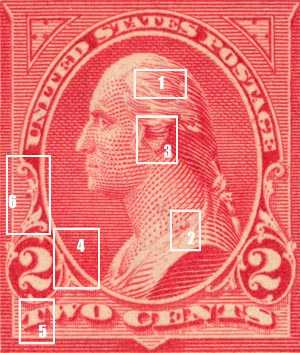
A Comparison of Types III and IV of the 2¢ Triangle of 1895 and 1898
Six Areas that Distinguish Types III and IV of the 2¢ Triangle
This is an often overlooked distinction, even among advanced collectors, many of the Type IV stamps are wrongly identified as the Type III, US 267. When trying to distinguish if your watermarked stamp is the Type III or the Type IV, US 279b, it may require looking at many of the areas on the map below to make the determination, particularly if the stamp is cancelled and key areas are hidden. The first two areas, the line in the hair and the extra shading in the toga button, are the most telling.
| Area on Map | Part of Design | 267 Type III | 279b Type IV |
| 1 | Line in Hair | line is short | line has been lengthened |
| 2 | Toga Button | button is taller than wide | button is wider than tall |
| 3 | Dots in Ear | dots are weaker | dots are usually stronger |
| 4 | Portrait Oval | few, if any jagged edges | jagged to very jagged edges |
| 5 | "T" of "TWO" | inner right edge curved |
inner right edge straight |
| 6 | Line in Acanthus | often well-defined | never well-defined |
As mentioned above, the line in the hair and the toga button are the major identifiers. If there is no extension of the line in the hair and if the toga button is taller than it is wide, the stamp is almost certainly a Type III, the US 267 of 1895. Conversely, if there is a strengthened line of hair and added shading in the toga button (wider than tall), the stamp is almost certainly the Type IV, the US 279b of 1898.
In a 1955 article in "The Bureau Specialist" Brett and Southgate propose 17 areas that distinguish the Type III and IV stamps and in fact there are many other distinctions. We have noted that many of the Type IV stamps are of poorer quality, not quite as bad, but reminiscent of the poor quality of the offset Washington Franklins. For this reason, many of the Type III stamps have much clearer definition in the line in the acanthus, often enough to be included in our top six distinctions. Notably, we did not observe a consistent enough difference in the lines of shading on Washington's sleeve, to include it in this list.
There are other criteria that will enable immediate identification of Type. If the watermarked stamp is cancelled or on cover with a date stamp prior to November of 1897, the earliest known usage of the Type IV stamp, the stamp is certainly the 267.
If the stamp is part of a block or strip with a plate number, identification is immediate. According to the "Durland Standard Plate Number Catalog" the plate numbers on the Type III range from 141 up to 503 and the plate numbers on the Type IV range from 505 up to 1493. Thus if the plate number on the watermarked stamp is 505 or higher it must be US 279b.
Finally, the idea that color may be the determining factor in distinguishing US 267 from 279b holds no merit. True, the issues of 1898 reflect color changes to conform with the UPU guidelines, but the 2¢ stamp was already the proper "red" color and no color change was necessary. For practical purposes the same variations in shades of color occur on both the 267 and the 279b and should not be considered in making the determination.
Further reading:
Durland Standard Plate Number Catalog - Compiled and edited by Kim D. Johnson with assistance from W. Wallace Cleland and John L. Larson
"Two-Cent Series of 1894, Type IV", George W. Brett and H. M. Southgate, The Bureau Specialist, Vol. 27, No. 10 (October, 1955) pp. 283-293
"The Two-Cent 1894: An Uncatalogued Major Variety" , George W. Brett, The United States Specialist, Vol. 64, No. 9 (September, 1993) pp. 390-395
Kenneth Diehl, The United States Specialist, Vol. 65, Dec. 1994 - Vol. 68, Aug. 1997, a 23-part article
Types of
the 2¢ Washington of the "Triangle" Series of 1894-1898






